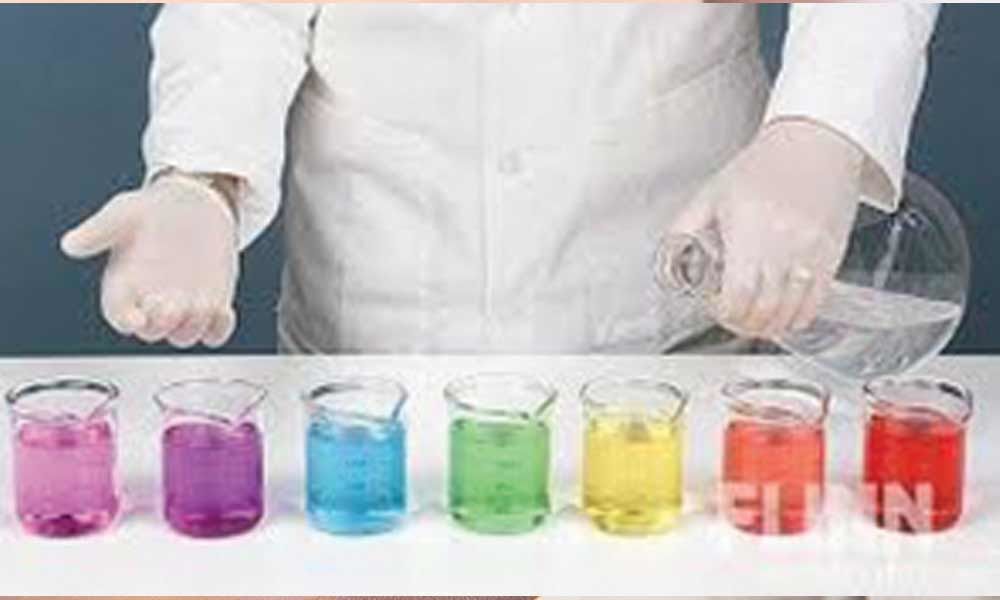Live
- Manu Bhaker applied for Khel Ratna but was shockingly overlooked: Sources
- Jagga Reddy's 'Prajasabha' in Sangareddy Postponed
- HYDRA Commissioner Ranganath Visits ORR, Inspects Multiple Lakes
- Improvement in Sriteja's Health Condition; Ventilator Removed and Liquid Diet Administered
- Former SC judge V. Ramasubramanian appointed as NHRC Chairperson
- Shyam Benegal: A true inspiration for aspiring film-makers
- Heavy snow forecast in Japan through Tuesday
- Legendary film-maker Shyam Benegal is no more
- Hackers steal over $12.7 billion in over 1,000 crypto heists to date
- BGT: 'Rohit is short of confidence with self-doubts', opines Manjrekar
Just In

Magic show or chemistry lab? Sometimes it’s hard to tell the difference! Chemical reactions often produce spectacular color changes that appear to happen just by magic. Now is your chance to put some tricks up your sleeve and wow your friends with scientific sleight of hand.
Magic show or chemistry lab? Sometimes it's hard to tell the difference! Chemical reactions often produce spectacular color changes that appear to happen just by magic. Now is your chance to put some tricks up your sleeve and wow your friends with scientific sleight of hand.
What You Do: Put 25 drops of universal indicator into the first flask, and then add 200ml of water. In the second flask, put a dropper-full of vinegar. Add a dropper-full of ammonia to the third flask.
(Be very careful not to breathe in the strong fumes from the ammonia!) Put 100ml of vinegar in the fourth flask. Slowly pour the contents of the first flask into the second one, then the second into the third and the third into the fourth.
What Happened: The secret of this magic color change is pH. Chemicals with a low pH (0-6) areacidic, while those with a high pH (8-14) are basic. (A pH of 7 is neutral: neither acidic nor basic.) Universal indicator is a chemical that changes color in the presence of acids and bases from a pH of 2 to 10. Acids turn the indicator red, pink, orange, and yellow, while bases turn it green, blue, and purple.
Vinegar is an acid, so when you poured the indicator solution into the second flask, it turned red. Ammonia is a base, so when you mixed the acidic vinegar solution with ammonia, it raised the pH and the water turned blue. If you had enough vinegar in your last flask, the solution should have turned red again. (If it didn't, try adding a little more vinegar.)
What You Do: In the first glass put a little less than 1/8 teaspoon of sodium carbonate, in the second put 6 drops of phenolphthalein solution, and in the third put three droppers-full of vinegar. Add a few drops of water to the first glass and stir to dissolve the sodium carbonate.
Fill all the glasses with water from the pitcher, and then pour all of them back in the pitcher except for the glass with vinegar. Refill the remaining four glasses – the water will be red! Now pour all five glasses back in the pitcher. Refill the glasses one last time — the liquid will be colorless again!
What Happened: Like the universal indicator, phenolphthalein is a pH indicator, but it only turns colors in reaction to bases. When you poured the four glasses back into the pitcher, the phenolphthalein reacted to the sodium carbonate, a base, and turned the solution to red "kool-aid." To change it back to "water," all you had to do was add the acidic vinegar, which turned the phenolphthalein colorless again.
Invisible inks are also called sympathetic inks, and can be made with many different substances. Sometimes they appear when you heat them up; other times another chemical can reveal them. Get creative and see how many kinds of invisible ink you can find.
What You Do: Choose a liquid like lemon juice to use as ink. Write a message on a piece of white paper using a paintbrush or q-tip, dipping in the ink frequently. Let the message dry. Turn on the toaster and carefully hold your paper over it. The heat will make your secret writing appear!
Some sympathetic inks appear and disappear again based on humidity. To try one of these, make a solution of 1/8 teaspoon cobalt chloride and 1/2 cup water. After writing your message and letting it dry, heat the paper to see your message appear in blue. Now hold the paper face down over a pan of steaming water.

© 2024 Hyderabad Media House Limited/The Hans India. All rights reserved. Powered by hocalwire.com







